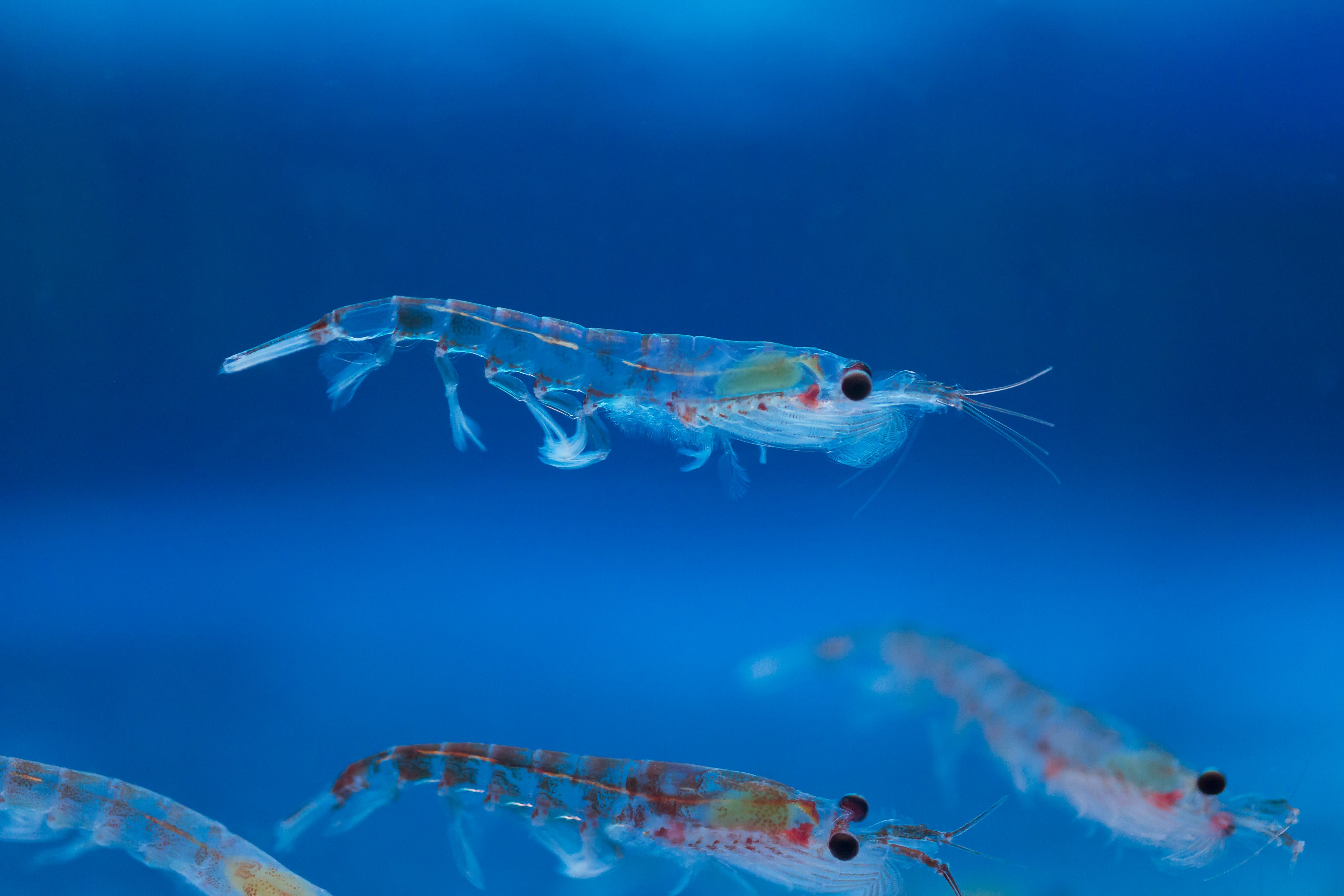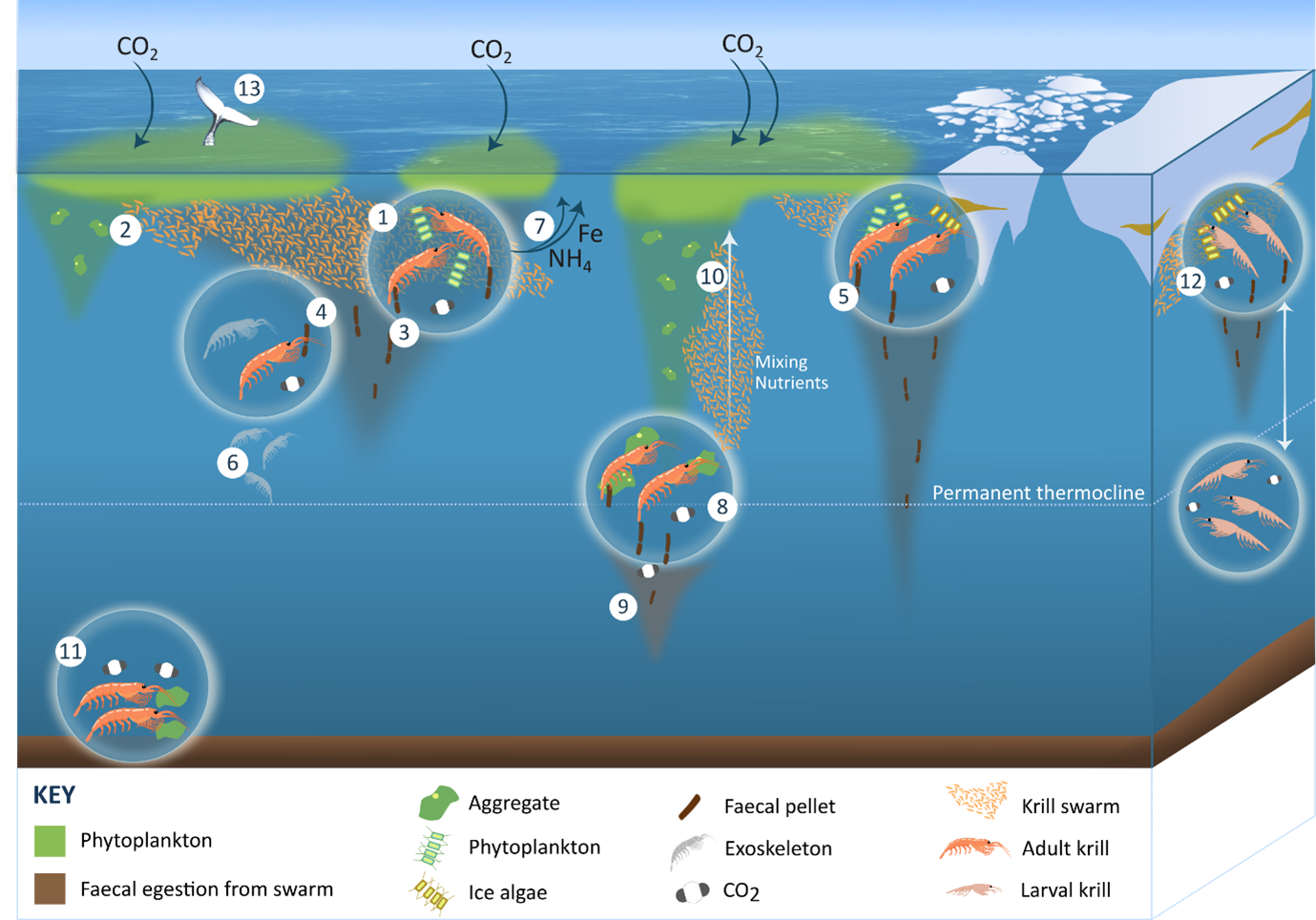Krill: The Carbon Highway of the Southern Ocean
Dr Anna Belcher is a Darwin Research Fellow and an Ecological Biogeochemist at the British Antarctic Survey. Here she discusses her research into the role Antarctic Krill play in our global climate.

Dr Anna Belcher is Darwin College Research Fellow and an Ecological Biogeochemist at the British Antarctic Survey. She studied her PhD at the University of Southampton and the National Oceanography Centre, also spending a year at the University of Washington, Seattle. He main research interests are marine biogeochemistry and the importance of biological processes for carbon cycling. Here she discusses her research into the role Antarctic Krill play in our global climate.
When we think of whale food, we think of krill, and vice versa. Yet these small swimming oceanic crustaceans also play a key role in global climate and ocean health.
Antarctic krill live in the Southern Ocean and gather in huge swarms that can extend over areas of about 100 km2 – about the same size as Jersey. This offers them protection from predators such as whales, penguins and seals, and can enable them to be more effective at finding prey.
Interestingly, about 90% of all Antarctic krill are found in a relatively small number of swarms (~5%). This patchy occurrence of krill, and their circumpolar distribution, makes it challenging to determine krill biomass in the Southern Ocean. We typically use nets as well as hydroacoustics, but each have their uncertainties and it isn’t currently feasible to carry out a synoptic survey of the entire 19 million km2 that is the Southern Ocean.
Combined efforts over many decades suggest that krill biomass could be as large as 379 million tonnes (which is about the same as estimates of global human biomass), with lower estimates of 215 million tonnes.
It is not surprising therefore that krill are a key food resource for Antarctic ecosystems. However, this is also one of the characteristics that makes them an important agent for the transfer of carbon to the deep ocean where it can be locked away for 1000 years or more.
Krill are strong swimmers, in fact, they never stop swimming their whole lives. This requires a lot of energy, necessitating krill to eat up to 10% of their body weight daily. The primary food of krill are diatoms, a type of marine phytoplankton which are found in the Southern Ocean and are rich in energy. These marine plants photosynthetically capture carbon dioxide from the atmosphere, locking the carbon up in their cells which is transferred higher up the food chain as they are fed on by marine animals. This is a key removal process of carbon dioxide from the atmosphere. However, much of this carbon is returned to the atmosphere when marine animals respire, or through bacterial degradation.
To remove carbon from the atmosphere for climatically relevant periods of time, we need to get that carbon deeper in the ocean, and hence increase the length of time that carbon spends out of contact with the atmosphere. This is where krill swarms come in!
Krill produce relatively large, fast sinking faecal pellets, which can descend quickly into the deep ocean. As large swarms of krill feed, this creates vast numbers of faecal pellets which rain down below the swarm. Although there are many detritivores living in the ocean that feed on sinking detritus – acting to respire the carbon back to carbon dioxide, we think that the sheer number and concentration of the faecal pellets means that they can overwhelm the grazing capacity of the detrital feeders. These intense feeding and bulk egestion events can therefore be particularly efficient at exporting carbon out of the surface ocean, acting as a carbon highway to the deep ocean.
With uncertain estimates of krill biomass, and the episodic nature of these intense export events, it is challenging to be able to directly measure just how much carbon krill can transport to the deep ocean. Focussing on the marginal ice zone, where sea-ice starts to open up into open waters, our current best estimates suggest that krill faecal pellets transfer 39 million tonnes of carbon out of the surface ocean – that is about the same as the total UK transport emissions in 2019! This is a minimum estimate since many krill live beyond the marginal ice zone.
Though delicious for whales, krill are also climate engineers, helping to lock carbon deeper in the ocean where it cannot return to the atmosphere so quickly.
It is therefore even more important that we ensure we protect the delicate polar environments that krill need to survive. Successful krill recruitment is supported by long lived winter sea ice cover and large diatom blooms in the spring and summer. Krill are therefore particularly vulnerable to warming ocean temperatures and reductions in sea ice. The long-term decline in sea ice and changes in the phytoplankton community composition could lead to reductions in krill populations.
There is evidence that changes in wintertime sea ice cover are related to declining krill populations and/or a shift in their distribution southward in the Atlantic sector of the Southern Ocean. These regions are particularly important nursery and spawning grounds, and thus has huge consequences for krill populations more widely in the Southern Ocean.
Krill are also commercially fished, used to produce aquaculture feed, as well as for pharmaceuticals. They are the most fished animal in the Southern Ocean. The fishery is closely managed by CCAMLR (Commission for the Conservation of Antarctic Marine Living Resources) who take an ecosystem-based management approach, trying to ensure that limits are set such that Antarctic marine food-webs are not impacted. This involves regulating not just how much krill can be taken, but also restricting where and when this can take place to protect key times and locations for krill recruitment, as well as foraging areas. Currently <1% of the krill population is fished each year. However, as human populations increase and global food security pressures rise, we need to be mindful that the protection of krill populations is important, not only to safeguard these fragile Antarctic ecosystems, but also to protect the role that krill play in our global climate.
Our daily lives and carbon footprint have far reaching consequences, impacting habitats and ecosystems on the other side of the globe. These impacts in turn feedback on our own lives by disrupting the role that nature plays in the stability of our climate. It has never been more pressing to consider the sustainability of our own actions and take action to support sustainable practices more widely.

Antarctic Krill. Photo Credit: British Antarctic Survey
Antarctic Krill. Photo Credit: British Antarctic Survey

Swimming Antarctic Krill
Swimming Antarctic Krill

The Krill Carbon Highway
The Krill Carbon Highway

Krill's Role in Biogeochemistry
Krill's Role in Biogeochemistry
